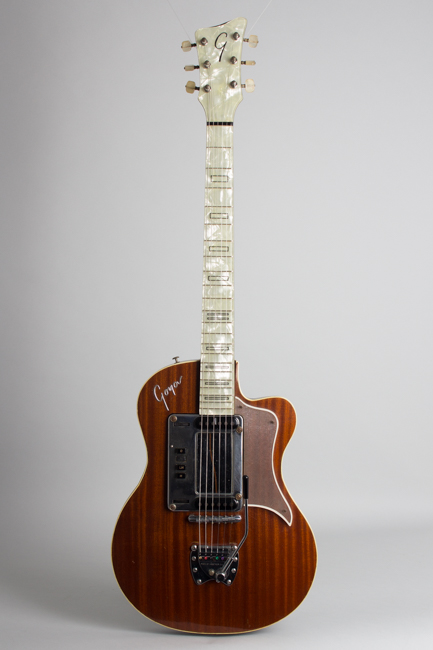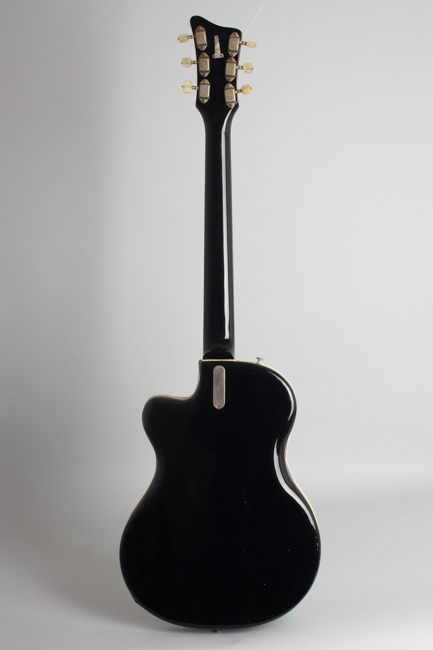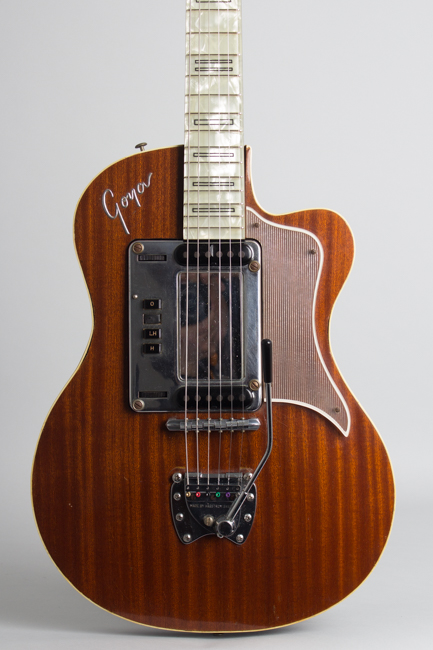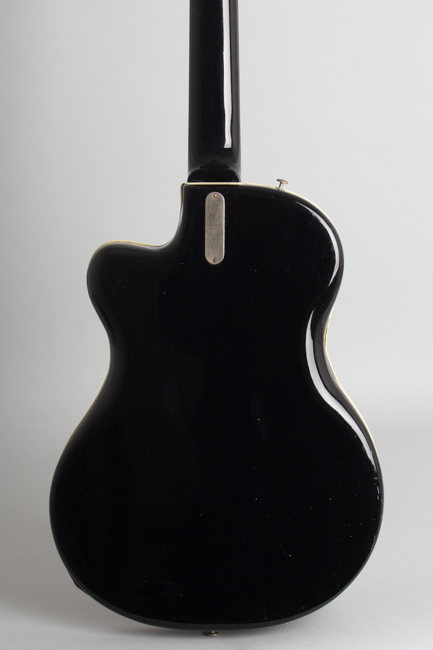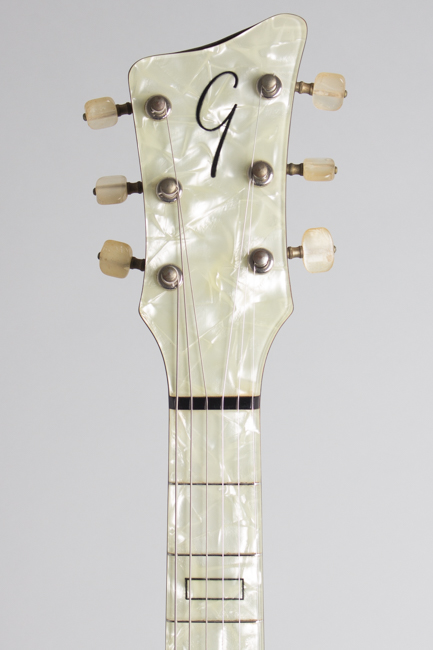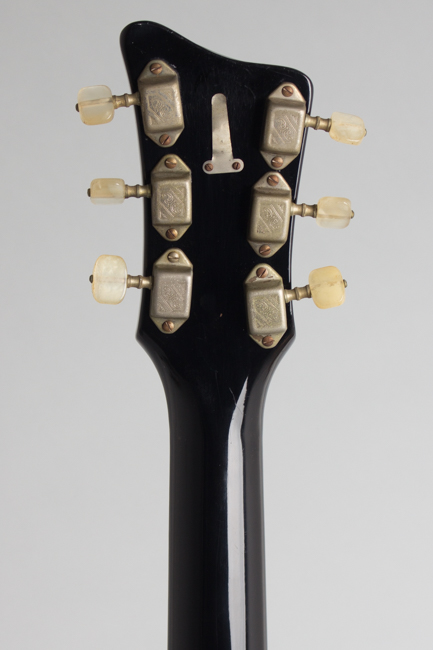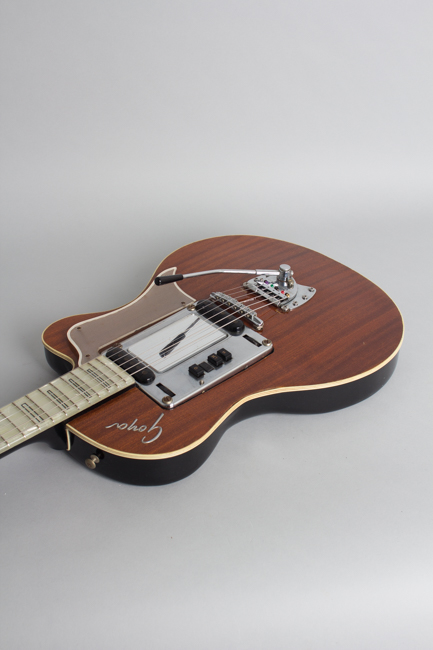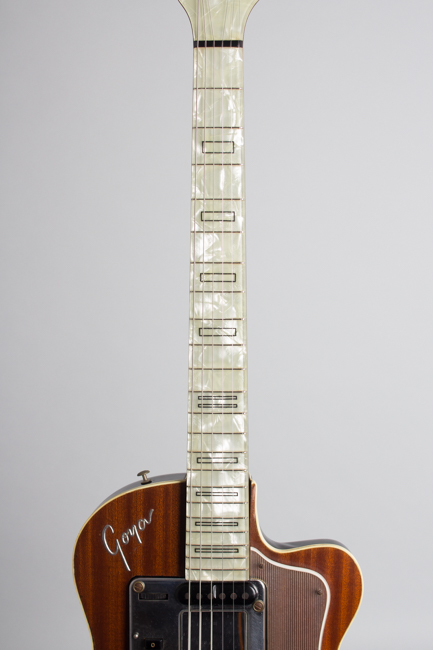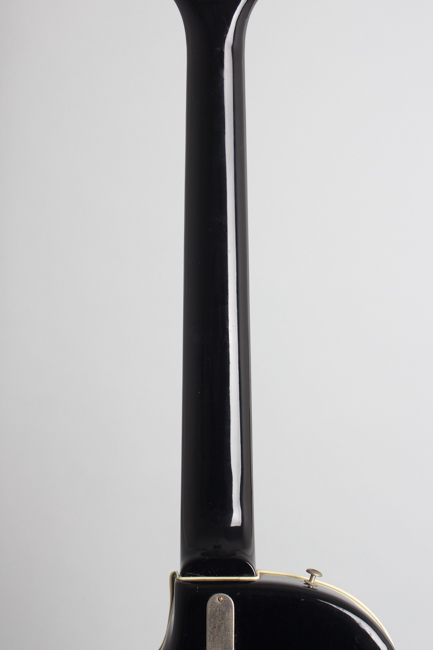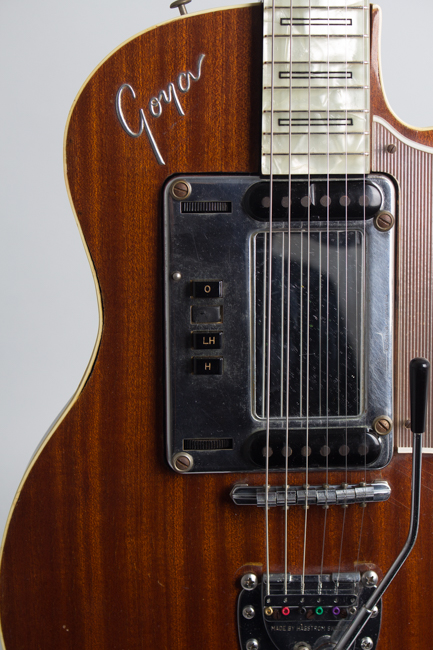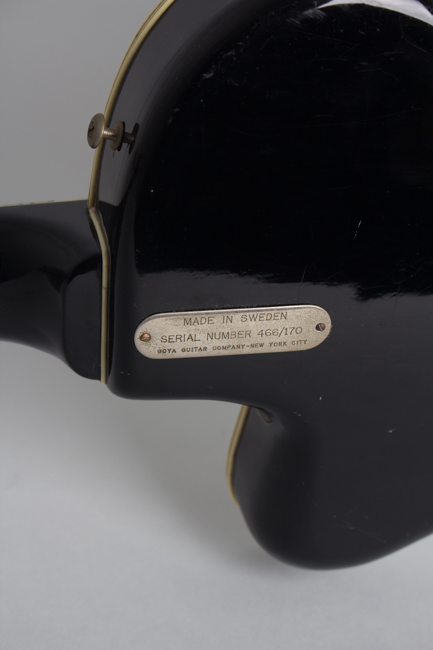Goya Model 90 Semi-Hollow Body Electric Guitar, made by Hagstrom (1960)
This item has been sold.
Item # 9222
Prices subject to change without notice.
Goya Model 90 Model Semi-Hollow Body Electric Guitar, made by Hagstrom (1960), made in Sweden, natural mahogany top, black plastic back and sides finish, hardwood body and neck, plastic sheathing and fingerboard, mahogany veneer face, black chipboard case.
What has a Spanish name, was sold in New York but made in Sweden, built of wood covered in plastic but faced with more wood? The answer is this Goya Model 90, one of the earliest and coolest of the imported guitars that flooded into the US during the 1960's guitar boom. Goya Guitars was a brand name owned the Hershman Musical Instrument Company of New York, who distributed mostly inexpensive acoustic guitars sourced from Levin Company in Sweden. When they decided to expand into electrics, the also Swedish Hagstrom Company seemed an obvious choice.
Hagstrom had already developed this nifty design, inspired by Gibson's Les Paul but with quite a bit of hollow space in the small body, more like the Gretsch Jet series. As with other European makers better versed in accordions, Hagstrom guitars made liberal use of plastic and pushbuttons shared with the squeezeboxes. This certainly gave them a distinctive look and feel, and Hagstrom built a number of original ideas into these flashy offerings.
The mostly hollow wooden body has black plastic sheathing on the back with white plastic edging around the front. The top is veneered with figured Sappeli mahogany, the same wood Guild used on the 1960's cherry Starfires. The bolt-on neck is also sheathed in black plastic, topped with a spectacular looking Lucite-over-pearloid fingerboard and headstock. This instrument marks the first appearance of the Hagstrom Adjust-O-Matic bridge and Tremar vibrato, both of which found their way onto a number of other 1960's guitars. The Tremar tailpiece on this guitar is the correct piece and period but was added to the guitar, possibly by the distributor as the screws for a stop tailpiece are still mounted in the top.
These guitars were available with several different interchangeable drop-in pickup units, another clever Hagstrom innovation. This one has the P-24 unit with two single-coil pickups and four pushbutton selectors, plus two rotary wheels. This is an entirely self-contained modular unit, mounted on springs in the body cavity and adjustable for height and angle. The mirrored insert in this one is probably not original, most have a sort of textured gold weave plastic inset as standard. It is very will fitted and looks really cool nonetheless, and really catches the light on stage!
The Model 90 can be distinguished from the similar Model 80 by a pointed pickguard and fancier enclosed tuning machines with pearloid buttons. These guitars are quite rare in the US at least as the Hagstrom/Goya arrangement lasted only about a year from 1960 to 1961. At that time this Model 90 DeLuxe sold for $135 while the Model 80 Standard was priced at $90. Recent research suggests there were only 177 of the Model 90 made and 370 of the Model 80 imported to the US. This Model 90 has wood instead of plastic on the face, a somewhat ironic touch as most of the Hagstrom models are faced in glitter but otherwise is about as flashy as it gets, a cool and very unique guitar. And it sounds great too!
Overall length is 39 3/4 in. (101 cm.), 13 in. (33 cm.) wide at lower bout, and 1 7/8 in. (4.8 cm.) in depth, measured at side of rim. Scale length is 24 1/2 in. (622 mm.). Width of nut is 1 5/8 in. (41 mm.).
Overall this is a nice example of this rare and rather whimsical guitar, showing some light average wear. The plastic sheathing on the body and neck show small dings and scuffs, with a just bit of shrinkage at the top of the headstock. The wood veneer top has some dings, dents and light checks. There is light spotting and staining to much of the metal hardware, but nothing too serious.
The only notable repair is one of the selector pushbuttons on the pickup unit has been replaced with a handmade replica with no engraving on the top. It does not match the others exactly, but does work. All other hardware is original and correct, with the caveat that the vibrato may have been added and the mirrored face is likely a later change as detailed above. Two of the tuners have slightly bent shafts, but all work as intended.
The neck is not absolutely straight, but is pretty close and the guitar plays quite well, at least as instruments with plastic fingerboard go. The Lucite fretboard itself and very narrow bar frets (that's right, bar frets) show hardly any wear at all. Housed in an indifferent but functional period chipboard case, this wooden guitar sheathed and plastic then faced in wood remains a delightful enigma, one of the early highlights of the imported guitar boom of the 1960's. Overall Excellent - Condition.
What has a Spanish name, was sold in New York but made in Sweden, built of wood covered in plastic but faced with more wood? The answer is this Goya Model 90, one of the earliest and coolest of the imported guitars that flooded into the US during the 1960's guitar boom. Goya Guitars was a brand name owned the Hershman Musical Instrument Company of New York, who distributed mostly inexpensive acoustic guitars sourced from Levin Company in Sweden. When they decided to expand into electrics, the also Swedish Hagstrom Company seemed an obvious choice.
Hagstrom had already developed this nifty design, inspired by Gibson's Les Paul but with quite a bit of hollow space in the small body, more like the Gretsch Jet series. As with other European makers better versed in accordions, Hagstrom guitars made liberal use of plastic and pushbuttons shared with the squeezeboxes. This certainly gave them a distinctive look and feel, and Hagstrom built a number of original ideas into these flashy offerings.
The mostly hollow wooden body has black plastic sheathing on the back with white plastic edging around the front. The top is veneered with figured Sappeli mahogany, the same wood Guild used on the 1960's cherry Starfires. The bolt-on neck is also sheathed in black plastic, topped with a spectacular looking Lucite-over-pearloid fingerboard and headstock. This instrument marks the first appearance of the Hagstrom Adjust-O-Matic bridge and Tremar vibrato, both of which found their way onto a number of other 1960's guitars. The Tremar tailpiece on this guitar is the correct piece and period but was added to the guitar, possibly by the distributor as the screws for a stop tailpiece are still mounted in the top.
These guitars were available with several different interchangeable drop-in pickup units, another clever Hagstrom innovation. This one has the P-24 unit with two single-coil pickups and four pushbutton selectors, plus two rotary wheels. This is an entirely self-contained modular unit, mounted on springs in the body cavity and adjustable for height and angle. The mirrored insert in this one is probably not original, most have a sort of textured gold weave plastic inset as standard. It is very will fitted and looks really cool nonetheless, and really catches the light on stage!
The Model 90 can be distinguished from the similar Model 80 by a pointed pickguard and fancier enclosed tuning machines with pearloid buttons. These guitars are quite rare in the US at least as the Hagstrom/Goya arrangement lasted only about a year from 1960 to 1961. At that time this Model 90 DeLuxe sold for $135 while the Model 80 Standard was priced at $90. Recent research suggests there were only 177 of the Model 90 made and 370 of the Model 80 imported to the US. This Model 90 has wood instead of plastic on the face, a somewhat ironic touch as most of the Hagstrom models are faced in glitter but otherwise is about as flashy as it gets, a cool and very unique guitar. And it sounds great too!
Overall length is 39 3/4 in. (101 cm.), 13 in. (33 cm.) wide at lower bout, and 1 7/8 in. (4.8 cm.) in depth, measured at side of rim. Scale length is 24 1/2 in. (622 mm.). Width of nut is 1 5/8 in. (41 mm.).
Overall this is a nice example of this rare and rather whimsical guitar, showing some light average wear. The plastic sheathing on the body and neck show small dings and scuffs, with a just bit of shrinkage at the top of the headstock. The wood veneer top has some dings, dents and light checks. There is light spotting and staining to much of the metal hardware, but nothing too serious.
The only notable repair is one of the selector pushbuttons on the pickup unit has been replaced with a handmade replica with no engraving on the top. It does not match the others exactly, but does work. All other hardware is original and correct, with the caveat that the vibrato may have been added and the mirrored face is likely a later change as detailed above. Two of the tuners have slightly bent shafts, but all work as intended.
The neck is not absolutely straight, but is pretty close and the guitar plays quite well, at least as instruments with plastic fingerboard go. The Lucite fretboard itself and very narrow bar frets (that's right, bar frets) show hardly any wear at all. Housed in an indifferent but functional period chipboard case, this wooden guitar sheathed and plastic then faced in wood remains a delightful enigma, one of the early highlights of the imported guitar boom of the 1960's. Overall Excellent - Condition.
